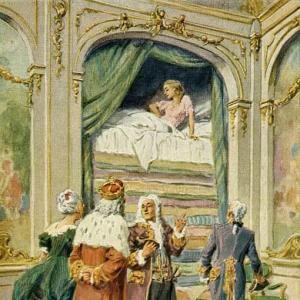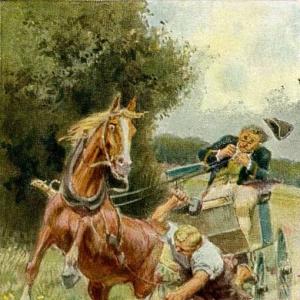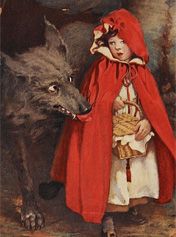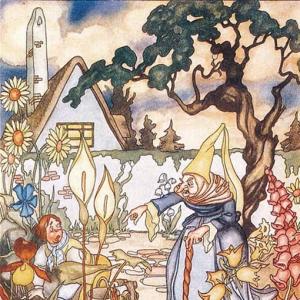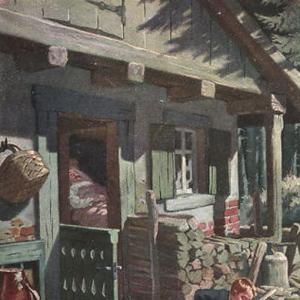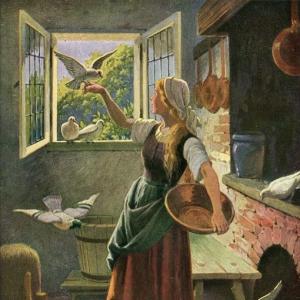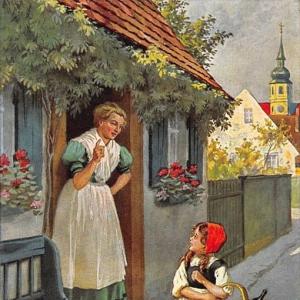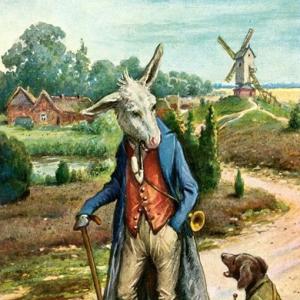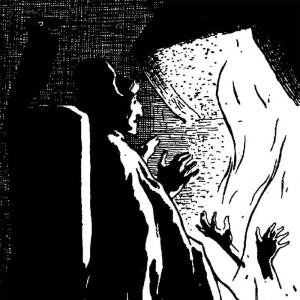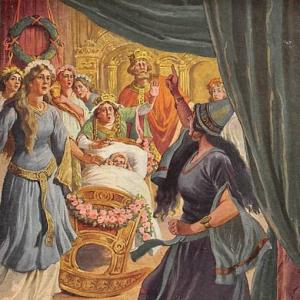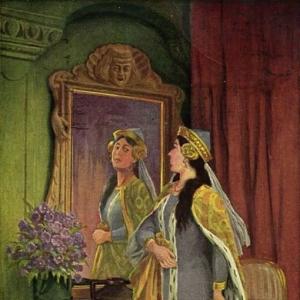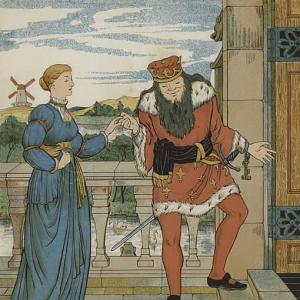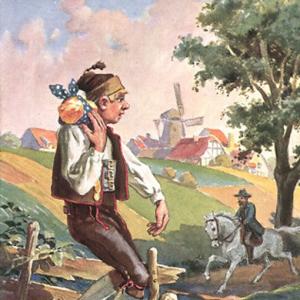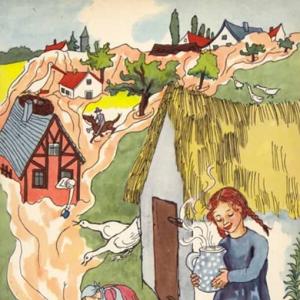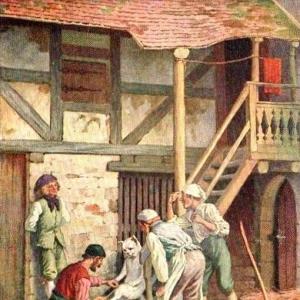Reading time for children: 4 min
There was once a poor woman who had a son, who much wished to travel, but his mother said, „How canst thou travel? We have no money at all for thee to take away with thee.“ Then said the son, „I will manage very well for myself. I will always say, ‚Not much, not much, not much.'“
So he walked for a long time and always said, „Not much, not much, not much.“ Then he passed by a company of fishermen and said, „God speed you! not much, not much, not much.“ – „What sayst thou churl, not much?“ And when the net was drawn out they had not caught much fish. So one of them fell on the youth with a stick and said, „Hast thou never seen me threshing?“ – „What ought I to say, then?“ asked the youth. „Thou must say, ‚Get it full, get it full.'“
After this he again walked a long time, and said, „Get it full, get it full,“ until he came to the gallows, where they had got a poor sinner whom they were about to hang. Then said he, „Good morning; get it full, get it full.“ – „What sayst thou, knave, get it full? Dost thou want to make out that there are still more wicked people in the world is not this enough?“ And he again got some blows on his back. „What am I to say, then?“ said he. „Thou must say, ‚May God have pity on the poor soul.'“
Again the youth walked on for a long while and said, „May God have pity on the poor soul!“ Then he came to a pit by which stood a knacker who was cutting up a horse. The youth said, „Good morning; God have pity on the poor soul!“ – „What dost thou say, thou ill-tempered knave?“ and the knacker gave him such a box on the ear, that he could not see out of his eyes. „What am I to say, then?“ – „Thou must say, ‚There lies the carrion in the pit!'“
So he walked on, and always said, „There lies the carrion in the pit, there lies the carrion in the pit.“ And he came to a cart full of people, so he said, „Good morning, there lies the carrion in the pit!“ Then the cart pushed him into a hole, and the driver took his whip and cracked it upon the youth, till he was forced to crawl back to his mother, and as long as he lived he never went out a-travelling again.
 Learn languages. Double-Tap on one word.Learn languages in context with Childstories.org and Deepl.com.
Learn languages. Double-Tap on one word.Learn languages in context with Childstories.org and Deepl.com.Backgrounds to fairy tale „Going a-travelling“
„Going a-Travelling,“ also known as „Going Traveling“ or „The Traveling Animals,“ is a lesser-known Brothers Grimm fairy tale that belongs to their collection „Grimms‘ Fairy Tales.“ The story, like many others in the collection, has its roots in German and European folklore and oral traditions.
In the story, several animals—namely a donkey, a dog, a cat, and a rooster—decide to go on a journey together. Each of them is no longer of use to their respective owners and fears being put to death. The animals form a bond and decide to travel to Bremen, a city famous for its musicians, to start a new life as musicians themselves.
The backgrounds of this fairy tale can be traced to several cultural, literary, and historical influences:
Folklore and oral traditions: As with many Grimm fairy tales, „Going a-Travelling“ has its roots in various folktales and oral traditions from Germany and other European countries. The Brothers Grimm collected these stories from diverse sources, including friends, family members, and local storytellers.
Animal fables: The tale is a part of a broader tradition of animal fables in European literature, which use anthropomorphized animals as characters to convey moral lessons, satirical commentary, or allegorical messages. The story shares some similarities with Aesop’s fables and other animal tales, such as „Reynard the Fox.“
Social commentary: „Going a-Travelling“ can be seen as a reflection of the social and economic conditions of the time when the story was collected. The tale may touch on themes of economic hardship, displacement, and the search for a better life, which were relevant to many people in 19th-century Europe.
The power of friendship and teamwork: At its core, the story emphasizes the importance of friendship, teamwork, and mutual support. The animals, despite their different backgrounds, find strength and hope in their shared journey, ultimately creating a new life together.
Literary influences: The Brothers Grimm were inspired by the works of other writers and collectors of folktales, such as Charles Perrault and Hans Christian Andersen. These authors also included animal tales in their collections, providing inspiration for the Grimm brothers to include similar themes in their own work.
In summary, „Going a-Travelling“ is a Grimm fairy tale that combines elements from folklore, animal fables, social commentary, and literary influences to deliver a timeless message about the power of friendship, teamwork, and perseverance in the face of adversity.
Interpretations to fairy tale „Going a-travelling“
„Going a-Travelling“ is a charming and thought-provoking tale that offers various interpretations, reflecting on human nature, values, and society. Here are some possible ways to understand the story:
The power of friendship and teamwork: One of the central themes of „Going a-Travelling“ is the importance of friendship, teamwork, and mutual support. The animals, despite their differences, come together to embark on a shared journey and create a new life for themselves. This interpretation emphasizes the value of working together and the strength that can be found in unity.
Overcoming adversity: The story can be seen as an allegory for overcoming adversity and finding new beginnings. Each of the animals is facing hardship and fears death due to their lack of usefulness to their owners. By joining forces and embarking on their journey, the animals demonstrate resilience and determination in the face of difficult circumstances.
Social commentary: „Going a-Travelling“ can be interpreted as a reflection of the social and economic conditions of the time when the story was collected. The tale may touch on themes of economic hardship, displacement, and the search for a better life, which were relevant to many people in 19th-century Europe. In this sense, the animals‘ journey to Bremen could symbolize the quest for opportunities and a better future.
The importance of self-worth and purpose: Each of the animals in the story has lost their sense of purpose and self-worth due to their lack of usefulness to their owners. However, by joining together and setting out on their journey, they rediscover their value and find a new sense of purpose. This interpretation emphasizes the importance of self-worth and the need to find one’s purpose in life.
Age and experience: The tale can also be seen as a celebration of age and experience. The animals, who are all considered old and useless by their owners, use their wisdom and skills to survive and thrive in their new life together. This interpretation highlights the value of age and experience and encourages respect for older individuals.
In conclusion, „Going a-Travelling“ is a multi-layered tale that offers multiple interpretations, encouraging readers to reflect on themes such as friendship, teamwork, overcoming adversity, self-worth, purpose, and the value of age and experience.
Adaptions of the fairy tale „Going a-travelling“
„Going a-Travelling,“ also known as „The Bremen Town Musicians,“ has inspired numerous adaptations across various forms of media. Some examples include:
Literature: The tale has been retold and adapted in various children’s books, with authors adding their own twists or providing illustrations to accompany the story. One example is „The Bremen Town Musicians“ by Brian Wildsmith, which offers a beautifully illustrated version of the classic tale.
Theater: The story has been adapted for the stage, both as standalone plays and as part of larger collections of Grimm fairy tales. For instance, „The Bremen Town Musicians“ has been included in children’s theater productions and has even been adapted into a full-length musical by Don Wilson.
Animation: The tale has been turned into animated films and television shows, primarily for children. A notable example is a 1969 Soviet stop-motion animated film titled „Town Musicians of Bremen“ (Bremenskie muzykanty), directed by Inessa Kovalevskaya. The film and its sequel, „On the Trail of the Bremen Town Musicians“ (1973), add new elements to the story while maintaining the original theme of friendship and teamwork.
Art: The story has inspired visual artists to create paintings, illustrations, and sculptures that depict scenes or characters from the tale. One famous example is the statue of the Bremen Town Musicians by Gerhard Marcks, which stands in the city of Bremen, Germany. The statue has become a popular tourist attraction and symbol of the city.
Music: Composers have used the story as a basis for musical compositions, such as operas, ballets, or symphonic works. An example is „The Bremen Town Musicians,“ a chamber opera by German composer Giselher Klebe, which adapts the tale for a modern audience while preserving the themes of friendship and teamwork.
Though „Going a-Travelling“ or „The Bremen Town Musicians“ might not be as widely recognized as some other Grimm fairy tales, it has captured the imaginations of artists and audiences alike, inspiring a variety of adaptations that emphasize the timeless themes of friendship, teamwork, and resilience.
Adaptions of the fairy tale „Going a-travelling“
The fairy tale „Going a-travelling“ (also known as „The Wishing Table, the Gold Ass, and the Cudgel in the Sack“) has been adapted into various forms over the years, including:
Children’s books: The story has been adapted into numerous children’s books, both as standalone tales and as part of collections of Grimm’s fairy tales. Some popular adaptations include „The Wishing Table and Other Stories“ by Clifton Johnson and „The Golden Ass: A Fairy Tale“ by Jenny Koralek.
Plays and operas: The story has also been adapted for the stage and opera. One notable adaptation is the children’s opera „The Wishing Table“ by Seymour Barab, which premiered in 1968.
Films and television: The story has been adapted into several films and television shows. One example is the 1954 German film „Das Wirtshaus im Spessart“ („The Spessart Inn“), which is loosely based on the fairy tale.
Video games: The story has even been adapted into video games, such as the 2015 game „The Wishing Table“ by indie developer KlickTock.
Overall, the enduring popularity of „Going a-travelling“ can be seen in the numerous adaptations and retellings of the story across various media over the years.
Summary of the plot
„Going a-Travelling,“ also known as „The Bremen Town Musicians,“ is a Brothers Grimm fairy tale about four animals—a donkey, a dog, a cat, and a rooster—who, fearing they are no longer useful to their owners and may face death, decide to leave their homes and embark on a journey together.
The animals form a bond and set out for Bremen, a city famous for its musicians, with the plan of starting new lives as musicians themselves. Along their journey, they come across a cottage inhabited by a group of robbers. The animals, using their wits and teamwork, scare the robbers away by standing on each other’s backs and making loud noises.
The animals decide to settle down in the cottage, living happily together and never actually reaching Bremen. The robbers attempt to return to the cottage, but the animals, once again working together, manage to frighten them away for good.
In summary, „Going a-Travelling“ is a heartwarming tale that teaches valuable lessons about friendship, teamwork, and perseverance in the face of adversity. The story highlights the importance of finding one’s self-worth and purpose, as well as the strength and resilience that can come from unity and cooperation.
————
Backgrounds to fairy tale „Going a-travelling“
„Going a-travelling“ is a lesser-known fairy tale collected by the Brothers Grimm, Jacob and Wilhelm, who were German academics, linguists, and cultural researchers. They are renowned for their collection of European fairy tales and folk stories, published as „Grimm’s Fairy Tales“ (also known as „Children’s and Household Tales“ or „Kinder- und Hausmärchen“ in German). The first edition of the collection was published in 1812, and it went through several editions and expansions during the brothers‘ lifetimes.
The Brothers Grimm collected these tales as part of their efforts to preserve and document the cultural heritage of Germany and Europe, at a time when industrialization and urbanization were threatening to erode traditional storytelling and folklore. They aimed to capture the oral traditions and local color of the stories, presenting them in a form that could be enjoyed by both children and adults.
„Going a-travelling“ is a narrative that offers moral lessons and cultural insight, as many other Grimm’s fairy tales do. Like other stories in the collection, it features relatable characters and situations, making it appealing to readers from diverse backgrounds. Despite its relatively obscure status compared to other Grimm’s tales, „Going a-travelling“ remains an interesting example of the Brothers Grimm’s efforts to document and share the richness of European folk culture.
Interpretations to fairy tale „Going a-travelling“
„Going a-travelling“ is a cautionary tale that imparts several valuable lessons through the experiences of the protagonist. Here are some interpretations of the story:
The importance of context and communication: The protagonist’s encounters demonstrate that using the same expression in different contexts can lead to misunderstandings and unintended consequences. The story teaches the reader to be sensitive to the context of a situation and to communicate thoughtfully and appropriately.
Adapting to different situations: Throughout the tale, the youth learns to adapt his speech based on the various encounters he faces. This highlights the importance of being flexible and adjusting our behavior to suit different scenarios and people.
Learning from mistakes: The protagonist repeatedly faces negative consequences due to his choice of words. With each encounter, he learns a new expression that he believes is more appropriate. This illustrates the importance of learning from our mistakes and the value of personal growth.
Respecting others: The story emphasizes the need to treat others with respect and to be mindful of the impact that our words and actions can have on them. The youth’s inconsiderate comments result in misunderstandings and altercations, underscoring the importance of showing kindness and empathy toward others.
The dangers of naivety and inexperience: The protagonist’s misadventures reveal the potential pitfalls that can arise when venturing out into the world unprepared. His lack of experience and understanding lead to multiple setbacks, highlighting the importance of gaining knowledge and wisdom before embarking on new journeys.
Overall, „Going a-travelling“ is a moral tale that teaches readers about effective communication, empathy, adaptability, learning from mistakes, and the importance of experience and wisdom when facing new challenges.
Summary of the plot
„Going a-travelling“ is a Brothers Grimm fairy tale that tells the story of a poor woman and her son, who is eager to travel despite their lack of money. The son sets off on his journey, deciding to manage by always saying, „Not much, not much, not much.“ He encounters various people and situations, learning different expressions that he should use depending on the context.
First, he comes across a group of fishermen and says, „Not much, not much, not much.“ Offended by his words, the fishermen chastise him, and he learns to say, „Get it full, get it full.“ Next, the youth encounters a man about to be hanged and mistakenly says, „Get it full, get it full.“ He is punished and learns to say, „May God have pity on the poor soul.“
The youth continues his journey, repeating the phrase he had just learned, until he meets a knacker cutting up a horse. The knacker, angered by the youth’s inappropriate words, strikes him and teaches him to say, „There lies the carrion in the pit!“ The youth then comes across a cart full of people and, using his new phrase, offends them as well. They push him into a hole and whip him until he crawls back to his mother.
The story concludes with the youth vowing never to go traveling again, having learned the importance of using appropriate expressions in different situations.
Informations for scientific analysis
Fairy tale statistics | Value |
|---|---|
| Readability Index by Björnsson | 16.2 |
| Flesch-Reading-Ease Index | 98.2 |
| Flesch–Kincaid Grade-Level | 2.6 |
| Gunning Fog Index | 5.6 |
| Coleman–Liau Index | 5.3 |
| SMOG Index | 5.8 |
| Automated Readability Index | 1.6 |
| Character Count | 2.121 |
| Letter Count | 1.543 |
| Sentence Count | 35 |
| Word Count | 430 |
| Average Words per Sentence | 12,29 |
| Words with more than 6 letters | 17 |
| Percentage of long words | 4% |
| Number of Syllables | 489 |
| Average Syllables per Word | 1,14 |
| Words with three Syllables | 7 |
| Percentage Words with three Syllables | 1.6% |


